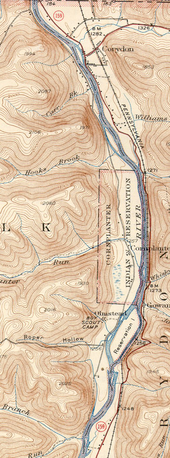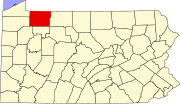Cornplanter Tract

The Cornplanter Tract or Cornplanter Indian Reservation is a plot of land in Warren County, Pennsylvania that was administered by the Seneca tribe. The tract consisted of 1,500 acres (610 ha) along the Allegheny River.
The tract comprised the only native reserved lands within the state of Pennsylvania during its existence. It was originally established in 1796 as a grant to Seneca diplomat Cornplanter, also known as John Abeel III, for his personal use, with the right to pass the plot down through his descendants forever.[1] Cornplanter promptly opened up his plot to native settlement, and within two years, 400 Seneca were living on the tract.[2] In 1918, most of Cornplanter's descendants were killed in the 1918 flu pandemic,[3] and Jesse Cornplanter, the last direct male heir, died in 1957 without having children,[4] with the land in the tract divided between a handful of indirect descendants in the Seneca tribe. The plot was already largely abandoned as a residence by the time of Jesse's death, and a 1941 map (seen at right) shows only scattered buildings on the tract. The tract was never connected to the electric power grid, and buildings there had to rely upon kerosene, coal and oil, which had to be used in furnaces specially built several feet above ground level, since even before the dam was built, the tract was prone to frequent flooding and roads to and from the tract were often unreliable.[5] The tract's one-room school closed in 1953, as only one elementary school-aged child remained on the tract; it had employed the same live-in teacher, Lucia Browne, since 1929.[5]
In the early 1960s, construction of the Kinzua Dam created the Allegheny Reservoir, which submerged the vast majority of the tract. Graves located in a cemetery on the tract mostly were exhumed and their bodies were reinterred in higher ground.[6][7][8]
References
[edit]- ^ "Chief Cornplanter". Pennsylvania Historical and Museum Commission. Archived from the original on March 7, 2015. Retrieved May 31, 2018.
- ^ "Cayuga: Our Oral Legacy - Home. Cayuga Digital Dictionary". Archived from the original on March 26, 2012. Retrieved May 27, 2012.
- ^ Bulletin of the New York State Museum, 1920. Section: "Death of Chief Edward Cornplanter," pages 104 and 105.
- ^ Lester, Patrick D. The Biographical Directory of Native American Painters. Tulsa, OK: SIR Publications, 1995: 125
- ^ a b Miller, Ernest C. (1958). "Pennsylvania's Last Indian School." Pennsylvania History, vol. 25, p. 99
- ^ "Cornplanter Cemetery - Warren County, Pennsylvania". Retrieved September 23, 2012.
- ^ "Cemetery Flooded by the Kinzua Dam". Retrieved September 23, 2012.
- ^ Alvin M. Josephy, Jr. (December 1968). "Cornplanter, Can You Swim?". American Heritage Magazine. Vol. 20, no. 1. Retrieved September 23, 2012.

